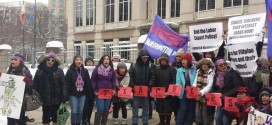By Amanda L. Andrei

Typhoon Haiyan (known locally as Yolanda), struck the Philippines on November 8, 2013. Nearly one year later, visiting Tacloban, Leyte, is a surreal experience. What does recovery look like an anniversary later?

Considered a transportation and trade hub for the islands of Leyte and Samar, Tacloban is one of the major cities in the Visayas region that suffered the most in loss of life and property. The official death toll of the typhoon is approximately 6,000 individuals, although the folk toll places the dead at over 10,000.

Arthur Puente is a survivor. A security guard and longtime resident of Tacloban, Arthur remembers dodging roofs that were ripped off by the tremendous gusts of wind. Even though his boss and colleagues told him to leave his post, he continued to guard the storehouse where he was assigned. After all, it was filled with guns and ammunition — and he was determined to keep his fellow citizens safe.

Much of the city is under repair. Mass grave memorials are within Tacloban as well as the surrounding towns. Palo has one mass grave in a church courtyard, and another in a traffic median along the highway. Within the median mass grave, a sculpture of tall, angular figures of concrete and rebar silently document the aftermath of the typhoon: handling the dead, carrying supplies, and filming the recovery. Despite their rough construction material origins and gray appearance, there is a delicacy to their slender limbs and a universal essence to their blank faces. They are no one, and yet they are every one.

Rebuilding efforts continue, as seen here within the scaffolds and rubble of the Basilica of Sto. Nino de Tacloban. And non-profit organizations such as Communitere, with its emphasis on “maker ethic” and sustainability, showcase an organic and upcycled garden within their local office grounds. Not only is property being renewed, but practices and processes and being rejuvenated.

Graffiti colors the walls of buildings and bridges, a public history book for citizens and foreigners to remember. And though there is a certain sadness to the city, the sense of hope is stronger. The city bustles noisily from sun-up until sun-down. Restaurants display menus, bazaars are lined with clothes and goods, tricycles and multicabs buzz up and down the streets. It’s not perfect–no disaster recovery ever is–but the survivors continue. Never forgetting. Never surrendering.
Photos taken from October 28-31 in Tacloban and Palo in Leyte, Philippines.
 Asian Fortune Your source for all things Asian American
Asian Fortune Your source for all things Asian American






